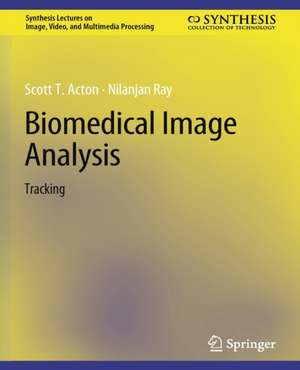Biomedical Image Analysis: Tracking: Synthesis Lectures on Image, Video, and Multimedia Processing
Autor Scott T. Acton, Nilanjan Rayen Limba Engleză Paperback – 31 dec 2007
Din seria Synthesis Lectures on Image, Video, and Multimedia Processing
-
 Preț: 428.68 lei
Preț: 428.68 lei -
 Preț: 191.30 lei
Preț: 191.30 lei -
 Preț: 206.84 lei
Preț: 206.84 lei -
 Preț: 450.88 lei
Preț: 450.88 lei -
 Preț: 234.87 lei
Preț: 234.87 lei -
 Preț: 191.30 lei
Preț: 191.30 lei -
 Preț: 193.01 lei
Preț: 193.01 lei -
 Preț: 260.77 lei
Preț: 260.77 lei -
 Preț: 234.87 lei
Preț: 234.87 lei -
 Preț: 234.87 lei
Preț: 234.87 lei -
 Preț: 234.87 lei
Preț: 234.87 lei -
 Preț: 234.87 lei
Preț: 234.87 lei -
 Preț: 311.69 lei
Preț: 311.69 lei -
 Preț: 351.41 lei
Preț: 351.41 lei -
 Preț: 234.87 lei
Preț: 234.87 lei -
 Preț: 234.87 lei
Preț: 234.87 lei -
 Preț: 262.47 lei
Preț: 262.47 lei -
 Preț: 234.87 lei
Preț: 234.87 lei -
 Preț: 206.45 lei
Preț: 206.45 lei -
 Preț: 261.53 lei
Preț: 261.53 lei
Preț: 264.20 lei
Nou
Puncte Express: 396
Preț estimativ în valută:
50.55€ • 52.92$ • 41.83£
50.55€ • 52.92$ • 41.83£
Carte tipărită la comandă
Livrare economică 05-19 aprilie
Preluare comenzi: 021 569.72.76
Specificații
ISBN-13: 9783031011092
ISBN-10: 3031011090
Ilustrații: VII, 144 p.
Dimensiuni: 191 x 235 mm
Greutate: 0.28 kg
Editura: Springer International Publishing
Colecția Springer
Seria Synthesis Lectures on Image, Video, and Multimedia Processing
Locul publicării:Cham, Switzerland
ISBN-10: 3031011090
Ilustrații: VII, 144 p.
Dimensiuni: 191 x 235 mm
Greutate: 0.28 kg
Editura: Springer International Publishing
Colecția Springer
Seria Synthesis Lectures on Image, Video, and Multimedia Processing
Locul publicării:Cham, Switzerland
Cuprins
Introduction.- Active Contours for Tracking.- Bayesian Tracking and the Kalman Filter.- Particle Filters and Multi-Target Tracking.- Tracking Shapes by Sampling.
Notă biografică
Scott T. Acton received the M.S. degree in electrical and computer engineering and the Ph.D. degree in electrical and computer engineering from the University of Texas at Austin in 1990 and 1993, respectively, where he was a Microelectronics and Computer Development Fellow. He received the B.S. degree in electrical engineering from Virginia Tech, Blacksburg in 1988 as a Virginia Scholar and Marshall Hahn Fellow. He was the class of 1984 valedictorian at Oakton High School in Vienna, VA. At Oakton, he was a member of the football and basketball teams, although the coach rarely let him in an actual game. He has worked in industry for AT&T, Oakton, VA, the MITRE Corporation, McLean, VA, and Motorola, Inc., Phoenix, AZ and in academia for Oklahoma State University, Stillwater. Currently, he holds the Walter N. Munster Chair for Intelligence Enhancement at the University of Virginia (U.Va.), where he is a member of the Charles L. Brown Department of Electrical and Computer Engineering and the Department of Biomedical Engineering. At U.Va., he was named the Outstanding New Teacher in 2002 and was elected a Faculty Fellow in 2003. For his research in video tracking, he was given an ARO Young Investigator Award. He received the Halliburton Outstanding Young Faculty Award in 1998. In 1997, he was named the Eta Kappa Nu Outstanding Young Electrical Engineer (a national award that has been given annually since 1936). He is the recipient of a Whitaker Foundation Biomedical Engineering Research Grant for work in cell detection and tracking. He currently is working on NIH-funded research for leukocyte tracking, segmentation of the myocardium from ultrasound, and segmentation of the myocardium from MRI. Dr. Acton is an active participant in the IEEE, served as Associate Editor for the IEEE Transactions on Image Processing and as Associate Editor for the IEEE Signal Processing Letters. He is the 2004 Technical Program Chair and the 2006 General Chair for the Asilomar Conference onSignals, Systems and Computers. His research interests include anisotropic diffusion, the history of Billy the Kid, active contours, biomedical segmentation problems, biomedical tracking problems, and war. Acton was a 2005 finalist in the Florida First Coast Novel Contest. He lives in beautiful Charlottesville, Virginia, with his wife and two boys. Nilanjan Ray received Bachelor of Mechanical Engineering from Jadavpur University, Calcutta, India in 1995; Master of Technology in computer science from Indian Statistical Institute, Calcutta, India in 1997; and Doctor of Philosophy in electrical engineering from the University of Virginia, Charlottesville, in 2003. From 2003 to 2005, he held a postdoctoral researcher position at C.L. Brown Department of Electrical and Computer Engineering, University of Virginia. Currently he is a senior research scientist at UtopiaCompression Corporation, Los Angeles, CA. Dr. Ray is a recipient of CIMPA-UNESCO fellowship for image processing school in 1999, graduate fellowship at Indian Statistical Institute from 1995 to 1997, best student paper award at IEEE international conference on image processing, held at Rochester, NY, 2002, from the IBM Picture Processing Society. Dr. Ray's research interests include object tracking using sequential Monte Carlo methods, applications of partial differential equations in image and video processing, image registration, and image denoising. Dr. Ray lives on the beach in LA with his wife and son.
